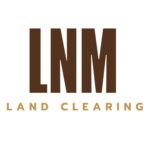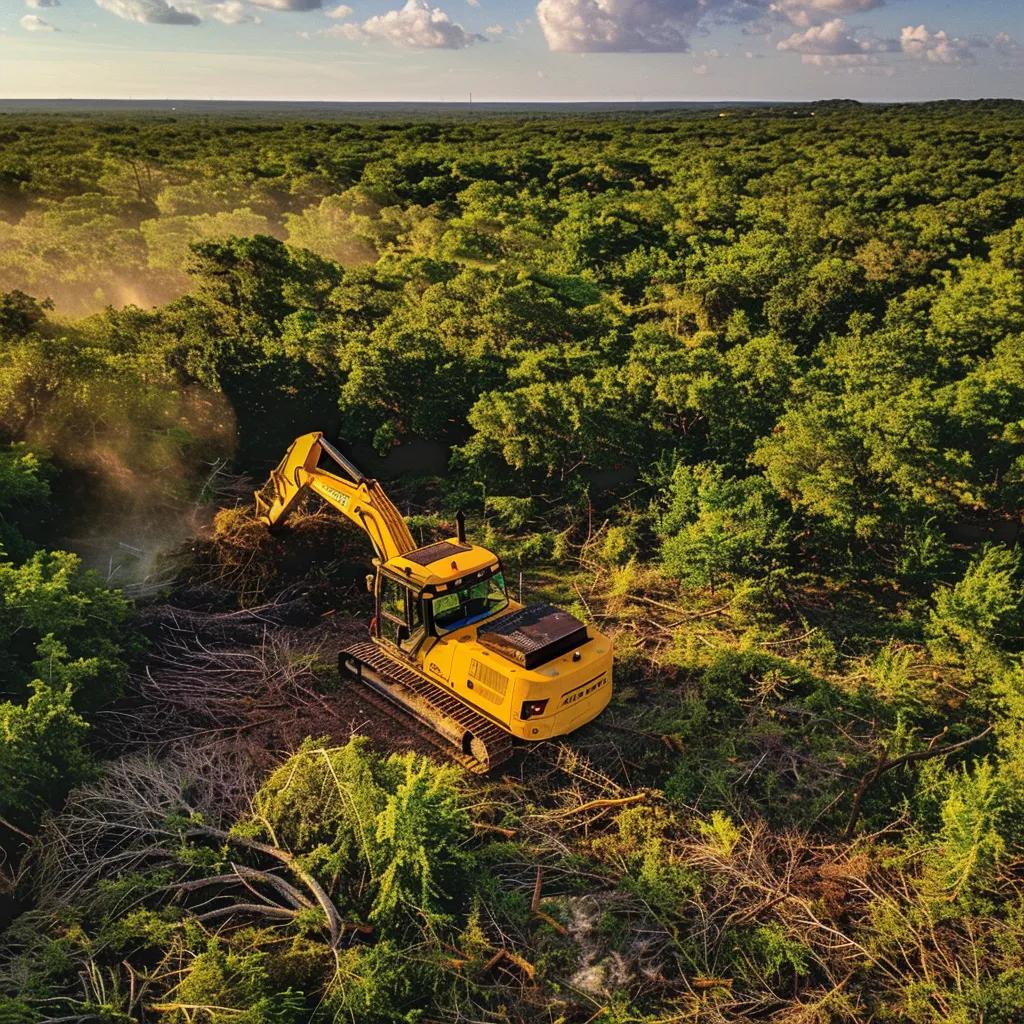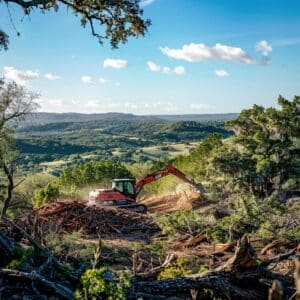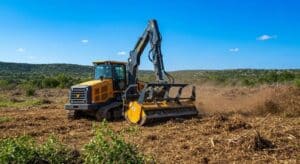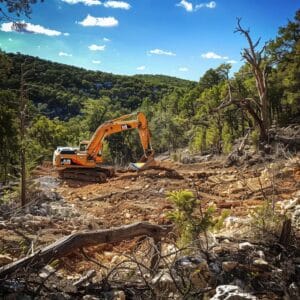Property owners and developers in Texas frequently encounter challenges with dense underbrush, invasive cedar, and fire-prone landscapes. Efficient forestry mulching services transform overgrown sites into clear, usable spaces by grinding vegetation into nutrient-rich mulch that remains on-site. This guide explores how forestry mulching works, its advantages over traditional clearing methods, and its benefits for soil health, erosion control, wildfire prevention, and cost savings. We will also cover equipment options, applications for various property types, pricing, and how to obtain a free quote.
Understanding Forestry Mulching vs. Traditional Land Clearing
Forestry mulching is a land clearing technique that grinds trees, brush, and vegetation into mulch in a single pass. This process preserves organic matter and enhances soil stability. In contrast, traditional land clearing often involves cutting, hauling, chipping, and sometimes burning or disposing of debris off-site, which is more time-consuming and costly. Forestry mulching acts as an integrated land clearing service, simultaneously removing, processing, and recycling vegetation to create an eco-friendly foundation for future development.
The Forestry Mulching Process
The forestry mulching process begins with a specialized mulcher attachment, typically mounted on a skid steer or excavator, designed to shred vegetation at the root level.
- The operator assesses the terrain and identifies any protected trees or features.
- High-speed mulcher teeth cut stems and grind underbrush into 1–3-inch mulch.
- The resulting mulch is deposited back onto the ground, acting as a natural weed suppressant and organic soil amendment.
This single-machine operation minimizes soil disturbance. The ground cover created by the mulch helps prevent erosion and enriches the site for subsequent landscaping or construction. Understanding this efficient process reveals how a single pass can replace multiple conventional land preparation steps.
Forestry Mulching vs Conventional Land Clearing
Here’s a comparison of forestry mulching and conventional land clearing methods:
| Clearing Method | Equipment | Debris Handling | Site Impact | Typical Applications |
|---|---|---|---|---|
| Forestry Mulching | Mulcher attachment | On-site mulch deposition | Minimal soil disturbance | Underbrush removal, firebreak creation |
| Conventional Clearing | Chainsaws, bulldozers | Hauling or burning debris | High soil compaction | Grading for roads, large-scale excavation |
| Mechanical Chipping | Standalone chipper | Chipped material hauled | Moderate disturbance | Waste wood processing |
This comparison highlights that forestry mulching saves time and preserves soil structure, making it ideal for projects where ecological integrity and speed are priorities.
Vegetation Types Handled by Forestry Mulching
Forestry mulching is effective for a wide range of vegetation, thanks to its versatile attachments:
- Small to medium trees (up to 8 inches in diameter)
- Dense underbrush, vines, palmetto, and briars
- Invasive species such as cedar, mesquite, and salt cedar
- Fallen logs and brush piles
Mulchers can adapt to various site conditions, addressing mixed species stands and invasive patches efficiently in a single pass. This versatility is a key reason many Texas landowners opt for this method over piecemeal removal.
Key Benefits of Forestry Mulching Services

Engaging local forestry mulching contractors offers property owners numerous advantages that extend beyond basic clearing.
Soil Health and Erosion Control
Forestry mulching enhances soil health by creating a protective mulch layer that improves moisture retention and nutrient cycling. The shredded biomass decomposes, releasing organic matter that fosters microbial activity and better soil structure. This natural ground cover significantly reduces surface runoff and soil loss on slopes, promoting vegetation regrowth and long-term site stability.
Wildfire Prevention and Firebreak Creation
This service effectively reduces “ladder fuels” and surface vegetation that can feed wildfires. By clearing a wide swath—typically 50–100 feet—around structures or property boundaries, professionals establish defensible firebreaks. Eliminating low-hanging limbs and dense undergrowth decreases fire intensity and slows its spread, enhancing safety for homes, livestock, and critical infrastructure.
Time and Cost Savings
A single forestry mulching machine can replace multiple pieces of equipment like chainsaws, chippers, skid steers, and haul trucks, consolidating several steps into one operation. This leads to:
- Elimination of debris hauling and burning fees.
- Reduction in labor hours by 40–60 percent.
- Faster site preparation by completing clearing, mulching, and minor grading simultaneously.
By reducing equipment rental, disposal, and labor costs, forestry mulching often provides savings of 20–30 percent compared to traditional multi-step clearing methods.
Environmental and Biodiversity Advantages
Beyond cost and time efficiencies, forestry mulching supports ecosystem health by:
- Promoting native seed germination under the protective mulch layer.
- Removing invasive species without the use of harmful chemicals.
- Retaining habitat structures for wildlife, such as logs and brush refuges.
This eco-friendly clearing approach helps maintain biodiversity and aligns with sustainable land management practices across Texas landscapes.
Forestry Mulching Equipment Options
Selecting the appropriate mulching attachment depends on the project’s scale, vegetation density, and terrain conditions.
Skid Steer Mulchers
Skid steer mulcher attachments are mounted on compact loaders, offering high maneuverability in confined spaces. Their compact footprint allows operation in yards, along fence lines, and on small lots, making them ideal for residential clearing and utility easements. Skid steer mulchers combine precision with power, positioning them as a top choice for urban and semi-rural property preparation.
Drum vs. Disc Mulchers
Both drum and disc mulchers effectively grind vegetation but differ in their cutting mechanisms and suitability for various conditions:
| Equipment Type | Cutting Mechanism | Ideal Vegetation | Maintenance Profile |
|---|---|---|---|
| Drum Mulcher | Drum with carbide teeth | Dense brush, small trees | Easier tooth replacement |
| Disc Mulcher | Rotating disc blades | Hardwoods, limestone areas | Requires blade sharpening |
Disc mulchers are better suited for rocky or mixed-wood sites, while drum mulchers offer cost-effective performance in brush-dominated areas.
Excavator Mulchers
Excavator mulchers are attached to backhoes and larger excavators, enabling them to handle steep slopes and heavy timber. Their extended reach and hydraulic power are advantageous for clearing creek banks and ravines, grinding large stumps and logs, and operating on grades exceeding 30 percent. This specialized equipment expands forestry mulching capabilities into terrain that skid steers cannot safely access.
Forestry Mulching Service Costs
Understanding pricing is crucial for landowners planning budgets and comparing quotes from local forestry mulching companies.
Typical Cost Per Acre and Per Hour
Forestry mulching rates in Texas generally fall within the following ranges:
- $500–$2,500 per acre for larger acreage projects.
- $100–$250 per hour for smaller jobs or hourly billing.
These prices can vary based on project complexity, site accessibility, and equipment mobilization requirements.
Factors Influencing Forestry Mulching Pricing
Several key factors influence the cost of forestry mulching:
- Vegetation density and the mix of species present.
- The steepness of the terrain and overall site accessibility.
- The total project size (acreage and lot shape).
- The required width for firebreaks or buffer zones.
Addressing these factors upfront ensures accurate proposals and helps prevent unexpected fees.
Minimum Fees and Mobilization Charges
Many forestry mulching providers implement a minimum service fee, typically ranging from $500 to $1,000, to cover travel and equipment mobilization costs. Remote locations or emergency wildfire mitigation efforts may incur additional mobilization surcharges. It is advisable to clarify these charges early in the process to avoid unforeseen expenses.
Common Applications of Forestry Mulching in Texas
Texas landowners utilize forestry mulching for a variety of purposes across residential, agricultural, and commercial sectors.
Residential Property Clearing
Homeowners often use forestry mulching to prepare building sites, create scenic views, and clear dense underbrush around their properties. Mulching around homes enhances curb appeal, reduces fire hazards, and preserves mature trees while leaving attractive mulch for landscaping.
Agricultural and Ranch Land Management
Ranchers and farmers employ forestry mulching to reclaim overgrown pastures, clear fence lines, and manage invasive cedar encroachment. The resulting mulch can improve grazing conditions, limit the spread of invasive species, and support pasture regeneration without the need for chemical herbicides.
Commercial Site Preparation and Development
Developers frequently rely on forestry mulching for right-of-way clearing, utility corridor creation, and preliminary site grading. By converting vegetation debris into on-site mulch, contractors can minimize haul-off costs and accelerate project timelines for roads, pipelines, and building foundations.
Why Choose Us for Your Next Forestry Mulching Services?
Land Clearing Near Me Contractors offers local expertise, modern equipment, and a strong commitment to safety and environmental stewardship for your forestry mulching needs.
Our Expertise and Equipment
Our certified operators are proficient with skid steer, drum, disc, and excavator mulcher attachments, ensuring the optimal machine is used for every project. With years of specialized experience in Texas ecosystems, we can accurately assess vegetation health, erosion risks, and wildfire hazards before commencing any clearing work.
Serving Specific Texas Locations
Our service areas cover major regions across Texas, from the rocky hill country of Fredericksburg to the expansive ranchlands of Central Texas. We maintain necessary local permits, understand municipal ordinances, and adapt our techniques to regional soil types and vegetation patterns for compliant and efficient clearing.
Customer Testimonials
Clients consistently praise our punctual scheduling, transparent pricing, and thorough site cleanup. Testimonials often highlight noticeable reductions in fire risk, improvements in pasture conditions, and accelerated construction start dates, underscoring our reliable and professional approach.
Get a Free Quote for Forestry Mulching Services
Requesting an accurate estimate is a straightforward process that requires only a few details and a brief site discussion.
Information Needed for an Estimate
To generate a precise quote, please provide the following information:
- Property dimensions or acreage.
- A description of the existing vegetation and its density.
- The desired clearing width or buffer zone.
- Information on access points and any protected zones on the property.
Providing photos or GIS coordinates can expedite the process and ensure clear expectations are set.
Scheduling Forestry Mulching Services
Our team typically schedules projects within 7–14 days of quote approval. Emergency wildfire mitigation efforts are prioritized as needed. Please note that seasonal demand may affect lead times, so early inquiry is recommended to secure preferred dates.
Frequently Asked Questions About Forestry Mulching
Here are concise answers to common questions regarding the environmental impact, invasive species control, and project timelines associated with forestry mulching.
What Are the Environmental Benefits of Forestry Mulching?
Forestry mulching preserves organic matter and prevents soil erosion by leaving a uniform layer of ground cover. This mulch decomposes into humus, enriching the soil with beneficial microbes and reducing the need for synthetic soil amendments.
Can Forestry Mulching Help Control Invasive Species Like Cedar?
Our mulching machinery grinds invasive species like cedar, including their roots, into fine material, effectively interrupting regrowth cycles without the use of chemical herbicides. Repeated treatments can help deplete invasive seed banks and encourage the reestablishment of native grasses.
Does Forestry Mulching Reduce Fire Risk in Texas?
Yes, forestry mulching is highly effective for reducing ladder fuels and surface vegetation that can accelerate wildfire spread. Creating defensible spaces up to 100 feet around structures and along property lines significantly mitigates flame spread and improves access for firefighters.
How Long Does a Typical Forestry Mulching Project Take?
Project duration varies depending on acreage and vegetation density. A typical project covering 5–10 acres of mixed underbrush and small trees might take 1–3 days. Smaller lots can often be cleared in a single day, while extensive ranchlands may require phased completion.
Ready to Transform Your Texas Property?
LandClearingNearMe.Contractors combines local knowledge, advanced mulching equipment, and transparent pricing to deliver efficient, eco-friendly land clearing solutions. Request a free consultation today to transform your Texas property with forestry mulching that protects soil, prevents fires, and accelerates your project timeline.
